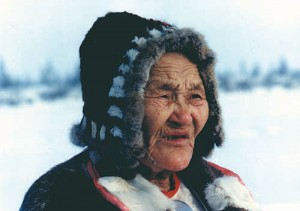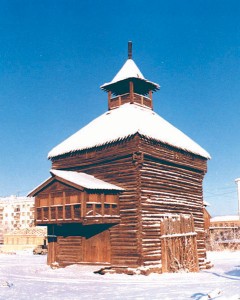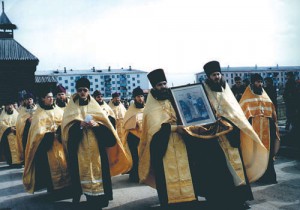 The name for the multinational republic comes from the name of its indigenous people, the Yakut. The Yakut formed an ethnic unity comparatively late, when Tungus- Manchurian herdsmen and protoyakut tribes had already settled on that territory. Living on the land with severe climate conditions, the Yakut formed an ethnic unity with one language, and called themselves sakha. Tungus-Evenk people used to name the Yakuts “Yako” and transferred this pronunciation to Russians whom they met before the Yakut. Russians named the Yakut “yakolskiye liudi (yakolskiye people)”. Gradually phonetic changes formed the modern name of the nation.
The name for the multinational republic comes from the name of its indigenous people, the Yakut. The Yakut formed an ethnic unity comparatively late, when Tungus- Manchurian herdsmen and protoyakut tribes had already settled on that territory. Living on the land with severe climate conditions, the Yakut formed an ethnic unity with one language, and called themselves sakha. Tungus-Evenk people used to name the Yakuts “Yako” and transferred this pronunciation to Russians whom they met before the Yakut. Russians named the Yakut “yakolskiye liudi (yakolskiye people)”. Gradually phonetic changes formed the modern name of the nation.
The first meeting between the Lena Yakut people and groups of Russians occurred in the mid seventeenth century. Tygyn, toyon (prince) of the Khangalassky Yakuts, granted some territory for Russian building-sites. The Lensky Ostrog (Lensky Stockade) – future city of Yakutsk – was founded by Russian Cossack sotnik (lieutenant) Pyotr Beketov from the Enissey river. The 25th of September, 1632 is the date of the first stockade construction. In August, 1638, the Moscow Government formed a new administrative unit – Yakutsky uyezd – with a center in Lensky stockade. That is how a very distant “small town” became the center of huge territory under the command of the Moscow government.
Russians established agriculture. The members of religious groups who were banished to Yakutia in the second half of the nineteenth century, made a progressive impact on the agricultural development of the region. Skoptsi, dukhobors, and old-believers started to grow wheat, oats, and potatoes. Fur trade established commodity-money relations, that developed in the seventh decade of the eighteenth century after the abolition of the fur trade tax.
 Industry and transport began to develop at the end of the nineteenth century and the beginning of the twentieth century. This was also the beginning of geological research, mining, and local lead production, and the first steam boats and barges arrived. Industrial development was linked to the traditional trades of the peoples of Yakutia. Explorers noticed the high skill of yakut carpenters and joiners, jewelers and tailors. From the ancient times the Yakut used timber, leather, as well as iron, bronze, copper, silver, tin, lead, and gold. They knew casting and metalsmithing. Mammoth tusk carving is still popular.
Industry and transport began to develop at the end of the nineteenth century and the beginning of the twentieth century. This was also the beginning of geological research, mining, and local lead production, and the first steam boats and barges arrived. Industrial development was linked to the traditional trades of the peoples of Yakutia. Explorers noticed the high skill of yakut carpenters and joiners, jewelers and tailors. From the ancient times the Yakut used timber, leather, as well as iron, bronze, copper, silver, tin, lead, and gold. They knew casting and metalsmithing. Mammoth tusk carving is still popular.
In the beginning of the XX century everyday life in Yakut region (the way how our republic was called at that time) was not much different from that in the early times. Yakut people were still the most numerous ethnicity. Besides, the administrative center of Russia was far away; therefore people mainly continued to live by life of their ancestors – celebrated their holydays, bred cattle, followed the plow, fished and hunted. They had to work all year round hard to survive – making preparations and provisions in summer and constant struggle with frost in winter. The housefather had to feed all his large family and cattle, the housemother had to raise the children and see after household.
The level of living was low – a very few people could read and write, the married couples tried to bear as many children as possible in order to be sure that at least some of them will grow up till mature age. A lot of people died because of starvation, severe climatic conditions and diseases. Medicine was not developed, especially in the country area. If someone was seriously sick, the only hope was on the help of shaman. At that time there were still many shamans, some of whom were really powerful and could help people. It was believed that they could turn into the animals, communicate with the spirits, cure diseases and curse people with whom they are angry.
 A lot of inhabitants still lived in traditional Yakut dwellings of winter and summer type. Of course, the most of them were poor peasants, but also there were rich people who had a lot of cattle. They could be easily recognized by their clothes – made of good fur with a lot of silver jewelry. Even the saddles of their horses could have silver decorations and ornaments.
A lot of inhabitants still lived in traditional Yakut dwellings of winter and summer type. Of course, the most of them were poor peasants, but also there were rich people who had a lot of cattle. They could be easily recognized by their clothes – made of good fur with a lot of silver jewelry. Even the saddles of their horses could have silver decorations and ornaments.
You may get acquainted with Yakutia in the beginning of XX century and feel its spirit on the link http://dnevniki.ykt.ru/Powerbar/543170 and http://images.library.amnh.org/digital/index.php/items/browse/2?search=Jesup.
In 1992 former Yakut autonomous soviet socialist republic (YASSR) as part of USSR became the sovereign Republic of Sakha (Yakutia) as a part of the Russian Federation
